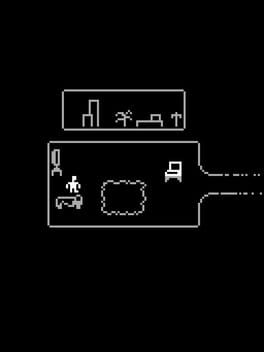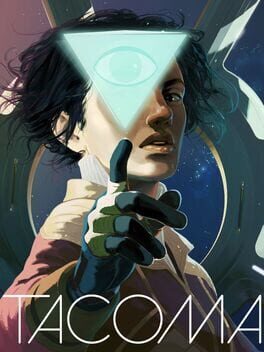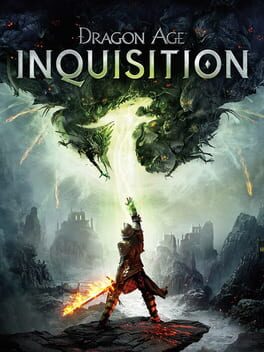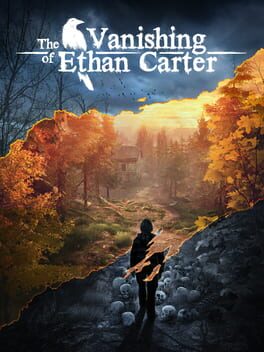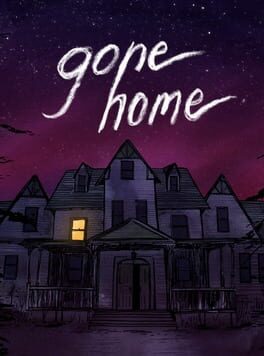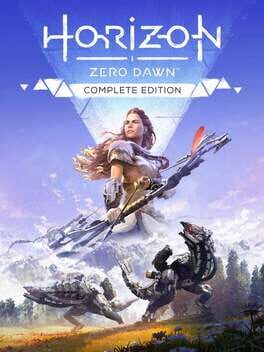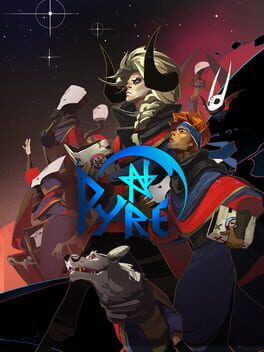hawkjones
Day 873: probably one of the only times that a "lack" of "gameplay" actually enriches the final product. The promise of a video game – movement, exploration, achievement – is denied almost entirely. Conventional indicators of progress have been reduced to essentially superficial changes, your group chat being the most dynamic thing that you can interact with (such as it is) in the room.
Probably more interesting as a commentary on video games than on world events, but I did enjoy it in that light.
Probably more interesting as a commentary on video games than on world events, but I did enjoy it in that light.
2001
Myst 3 can't be the first identifiably positivist video game ever made, but it's probably the first one that I've played. It proposes that the world we live in and the lives we lead are a puzzle– not only that constituent parts are interconnected, but also that problems are solvable. The universe as linear algebra (cf. a game like Pathologic or Pentiment, where there are ultimately no "good" answers).
Now, this proposition could have been easily and utterly ham-fisted if the entire game was comprised of ages like the Rube Goldbergian Amateria, where logic materializes in the form of machines that guide spheres on tracks. But Exile redeems itself through the age of Edanna, where an island's entire ecosystem becomes a puzzle to manipulate and solve. Clearly the abstract notion of a machine is being applied more broadly and in contentious ways.
While this nevertheless is in line with the suggestion that the universe is inherently knowable - that scientific and logical proofs can be used to explain reality - it is of course at odds with the mystical, creative process of The Art, which allows ages to be created through writing linking books. The Myst series up to this point never really explains how The Art functions. There is a sequence in the last part of Exile that comes very close, hewing close to its positivist inclinations, but it never really gets close to becoming fully expository.
So where does that leave us? People are only truly creative within limitations? Creativity is limited by the laws of reality? That creativity and logic are inextricably intertwined? The full weight of these questions are best understood by playing all three games up to this point, but Exile really ties the bow on it.
Now, this proposition could have been easily and utterly ham-fisted if the entire game was comprised of ages like the Rube Goldbergian Amateria, where logic materializes in the form of machines that guide spheres on tracks. But Exile redeems itself through the age of Edanna, where an island's entire ecosystem becomes a puzzle to manipulate and solve. Clearly the abstract notion of a machine is being applied more broadly and in contentious ways.
While this nevertheless is in line with the suggestion that the universe is inherently knowable - that scientific and logical proofs can be used to explain reality - it is of course at odds with the mystical, creative process of The Art, which allows ages to be created through writing linking books. The Myst series up to this point never really explains how The Art functions. There is a sequence in the last part of Exile that comes very close, hewing close to its positivist inclinations, but it never really gets close to becoming fully expository.
So where does that leave us? People are only truly creative within limitations? Creativity is limited by the laws of reality? That creativity and logic are inextricably intertwined? The full weight of these questions are best understood by playing all three games up to this point, but Exile really ties the bow on it.
2017
I will be the first to admit that I'm a bit of a sucker for sword and sorcery fantasy settings. If you want me to forgive - even enjoy - some of your most hackneyed tropes and mechanics, simply make them ~Tolkienesque~. Space marines fighting alien hordes? Derivative. Pathetic. An elf gathering enchanted herbs in a forest? Hell yes brother I am there. But even despite this predilection, 40 hours of DAI has left me unable to be compelled by... almost anything in the game.
This is an unusual experience for me, so I set about trying to diagnose the malaise. An easy answer might be the music: relatively sparse, and what's there is mostly generic Dorian scale fantasy orchestra. Not a mortal sin by any means, but its contributions to the game are fairly negligible.
The story, combat, lore, and environments can all be characterized similarly. The environments especially: layouts of most settlements are organized in such a manner that walking from one point to another requires a Family Circus-esque traversal of ramps and stairs. My guess is that the designers wanted to give the impression that each location is rich in histories that get reflected in their layout (like Brazilian favelas maybe [?]), but it ends up feeling like they plopped "Medieval Town – Free Pack 2" assets down onto a map and forgot to rotate them. They are missing the spatial logic that exists in actual lived-in towns. If Redcliffe existed in real life it would be littered with desire paths.
But I believe the real problem is that there's nothing that I can identify in DAI as distinctly "Dragon Age" aside from, of course, the dialogue system and cutscenes with people casually drenched in blood. Peer S&S games – Skyrim, The Witcher, D: OS 2, possibly even Pillars of Eternity, World of Warcraft, Trine, etc. – all have distinctive thematic and stylistic leitmotifs, despite using settings that are otherwise fairly off-the-shelf, or at least highly referential. In DAI, the designs of the character and codex cards are probably one of the best parts of the entire game and could have been expanded into something truly interesting– perhaps the story is told through cards, similar to a tarot deck, invoking questions of fate, storytelling, and tropes/archetypes themselves. Instead, the cards relegated entirely to being a neat design element. So while countless pieces of media have been described as "like Skyrim" over the past 11 years, I can't imagine what would make me say that something is "like Dragon Age" besides, perhaps, a beta version of a fantasy MMO.
Does this make it a bad game? No. I can imagine returning to this for something predictable and not very challenging. And lots of people seem to be heavily invested in the relationships between characters, for what that's worth. But I did feel like I was playing through the whiteboard brainstorming sessions for other games. With the budget and cachet available to them, this should have been a very different game.
This is an unusual experience for me, so I set about trying to diagnose the malaise. An easy answer might be the music: relatively sparse, and what's there is mostly generic Dorian scale fantasy orchestra. Not a mortal sin by any means, but its contributions to the game are fairly negligible.
The story, combat, lore, and environments can all be characterized similarly. The environments especially: layouts of most settlements are organized in such a manner that walking from one point to another requires a Family Circus-esque traversal of ramps and stairs. My guess is that the designers wanted to give the impression that each location is rich in histories that get reflected in their layout (like Brazilian favelas maybe [?]), but it ends up feeling like they plopped "Medieval Town – Free Pack 2" assets down onto a map and forgot to rotate them. They are missing the spatial logic that exists in actual lived-in towns. If Redcliffe existed in real life it would be littered with desire paths.
But I believe the real problem is that there's nothing that I can identify in DAI as distinctly "Dragon Age" aside from, of course, the dialogue system and cutscenes with people casually drenched in blood. Peer S&S games – Skyrim, The Witcher, D: OS 2, possibly even Pillars of Eternity, World of Warcraft, Trine, etc. – all have distinctive thematic and stylistic leitmotifs, despite using settings that are otherwise fairly off-the-shelf, or at least highly referential. In DAI, the designs of the character and codex cards are probably one of the best parts of the entire game and could have been expanded into something truly interesting– perhaps the story is told through cards, similar to a tarot deck, invoking questions of fate, storytelling, and tropes/archetypes themselves. Instead, the cards relegated entirely to being a neat design element. So while countless pieces of media have been described as "like Skyrim" over the past 11 years, I can't imagine what would make me say that something is "like Dragon Age" besides, perhaps, a beta version of a fantasy MMO.
Does this make it a bad game? No. I can imagine returning to this for something predictable and not very challenging. And lots of people seem to be heavily invested in the relationships between characters, for what that's worth. But I did feel like I was playing through the whiteboard brainstorming sessions for other games. With the budget and cachet available to them, this should have been a very different game.
2016
2014
Potentially interesting questions about personhood, but 3.5 hours into playing I had yet to find what was at stake. Was my character going to be deleted? Seems unlikely given the rewind effect after death. Are other entities coming after me? Maybe, but I only think that given the generally ominous atmosphere. Is my personhood as a gamer at stake? Maybe, but this question starts from the premise that personhood/humanity/etc. is some combination of desirable, necessary, and extant.
Let's say that I come to a conclusion about whether or not I'm a person. Okay cool. But who cares! I'm still playing the game. There are no consequences one way or another. Inside, Pathologic 2, The Beginner's Guide, and The Stanley Parable all at least reference the stakes of humanity. If this game does, I haven't made it there yet and, frankly, I'm not sure I want to get there.
Let's say that I come to a conclusion about whether or not I'm a person. Okay cool. But who cares! I'm still playing the game. There are no consequences one way or another. Inside, Pathologic 2, The Beginner's Guide, and The Stanley Parable all at least reference the stakes of humanity. If this game does, I haven't made it there yet and, frankly, I'm not sure I want to get there.
2022
2015
Played for about an hour or so. Someone with a higher tolerance for teen soap opera writing could probably push through the more hackneyed dialogue and find some worthwhile nuggets, but I just can't. The time rewinding mechanic was a great idea that was well-executed and deserved the praise it got for evolving storytelling in gaming.
2013
This review contains spoilers
There seems to be a sorta-trend amongst short indie games where they introduce this potentially interesting world and then wrap it up way too quickly. Gone Home introduces a few interesting ideas, layers a formulaic love story on top of it, and then bolts out of the room as soon as it’s credits time. Wish there was more.
2019
My god, what a rich field of inquiry utterly squandered by a man with a teenager's brain. Indulgence masquerading as insight. This is a child taking the most exquisite stones and flowers and bird nests from a forest, then covering them with paint and glue for their "project".
And to really drive home the fact that Kojima is sticking his entire schlong into your face, there are two (2 [TWO!!!]) unskippable credits sequences.
And to really drive home the fact that Kojima is sticking his entire schlong into your face, there are two (2 [TWO!!!]) unskippable credits sequences.
2017
I wish I could like this game more. The character and level design, the music, the sound, the setting, and the concept are all some of the best I've ever seen in a video game. I'd even say that the writing is some of the best in any Supergiant game.
But... something went wrong. I'll echo other reviewers by saying that I just stopped caring about the whole thing after about 3-5 hours. I'm not positive as to why, but I have some theories:
1) The cyclical nature of the gameplay makes logical sense in the game setting and for mechanics. Obviously Supergiant can pull off a repetitive game (see: Hades), but there may not have been quite enough variation between levels in Pyre to keep it exciting. I hit on a few general strategies with each character and stuck with them and that was it. The talismans and lineup changes didn't do much to alter my strategies.
2) I mentioned that the writing was the best for a Supergiant game, but the bar is pretty low in that regard. Every sentence sounds like it's occurring in the middle of a paragraph, or that you're missing context to understand it.
3) Character development proceeds along lines that you can see as soon as you meet each character. They change, sure, but this is a caravan of tropes and never get subverted, commented on, flipped, or anything other than what you'd come to expect.
It's a shame because Pyre is truly stunning and I still listen to the soundtrack while writing. It just felt like a chore to play for three quarters of my time with it.
But... something went wrong. I'll echo other reviewers by saying that I just stopped caring about the whole thing after about 3-5 hours. I'm not positive as to why, but I have some theories:
1) The cyclical nature of the gameplay makes logical sense in the game setting and for mechanics. Obviously Supergiant can pull off a repetitive game (see: Hades), but there may not have been quite enough variation between levels in Pyre to keep it exciting. I hit on a few general strategies with each character and stuck with them and that was it. The talismans and lineup changes didn't do much to alter my strategies.
2) I mentioned that the writing was the best for a Supergiant game, but the bar is pretty low in that regard. Every sentence sounds like it's occurring in the middle of a paragraph, or that you're missing context to understand it.
3) Character development proceeds along lines that you can see as soon as you meet each character. They change, sure, but this is a caravan of tropes and never get subverted, commented on, flipped, or anything other than what you'd come to expect.
It's a shame because Pyre is truly stunning and I still listen to the soundtrack while writing. It just felt like a chore to play for three quarters of my time with it.
2016
INSIDE asks questions about control. Why you are playing the game? Are you really playing the game? Are you really are playing the game? What is the game? Who else is playing the game? Are those people actually playing the game? A diagram of the thematic currents quickly starts to resemble a Mandelbrot set.
Superficially, this is a short, atmospheric 2.5D platformer. But the themes of the game are recursive, and build on one another until they collapse in on themselves, quite literally, in the climax. An experience that held a mirror up to the past 25 or so years that I've spent playing video games. It was uncomfortable and unforgettable.
Superficially, this is a short, atmospheric 2.5D platformer. But the themes of the game are recursive, and build on one another until they collapse in on themselves, quite literally, in the climax. An experience that held a mirror up to the past 25 or so years that I've spent playing video games. It was uncomfortable and unforgettable.
Breath of the Wild excels at nothing. More specifically, it excels at creating empty, peaceful moments with no combat, no countdown timer, no stress. Just running through a grassy field with the breeze rustling your hair, watching the sun set, listening to the birds and insects around you. White space. [This is possibly borne out of the “aspect to aspect” tendency in Japanese storytelling– for more, see Understanding Comics by Scott McCloud or Nerdwriter1’s video on Ghost in the Shell on YouTube] How does this differ from many other open world games with rich environments, such as Skyrim, RDR2, or The Witcher 3? I believe it has to do with the fact that, in most cases, you can actually insert yourself (or at least Link) into whatever vista you can see. This has implications beyond, as others have suggested, existing as a mechanical novelty.
The world doesn’t push back against your attempts to navigate it– in other games, this pushback may manifest as having to repeatedly bunny hop to scale a mountain, or your character not grabbing on to a ledge that appears to be graspable if it existed in real life. Instead, BotW has refined and intuitive navigation mechanics, making movement feel more similar to a game like THPS than Ocarina of Time. Paragliding to the back of your horse, then dismounting your horse to slide on your shield down a hill, then jumping off your shield to scale a cliff can all be strung together in an essentially unbroken chain. In short, the “physical” world of Hyrule is welcoming in a manner that is central to the video gaming experience itself, which is moving through space.
There’s one other thing that BotW excels at, which is presenting the player with an environment within which they can explore a series of (mostly) compatible systems. It does this extremely well with the exception of multi-enemy combat, where it could’ve benefitted from some improvements to the camera and targeting mechanics. Other people have discussed this at length so I’ll end my comments on the matter there.
Unfortunately, it was clear pretty early on that the story in BotW was going to be Extremely Nothing– no character development, no challenging questions, no provocations. I tried really hard to come up with a generous reading, and the best I could do is that it’s a parable about the dangers of weaponizing artificial intelligence? I guess? But even that is a secondary, almost incidental aspect of the main storyline so I’m not assigning it that much significance. The heart of the story is really about good versus evil full stop. This is a small tragedy, because given how beautifully the game deals with movement and environment, Hyrule as a place in time could have been more thematically significant, such as the Forbidden Land in Shadow of the Colossus. As it is, BotW is a product of what Nintendo does best, which is making toys.
The world doesn’t push back against your attempts to navigate it– in other games, this pushback may manifest as having to repeatedly bunny hop to scale a mountain, or your character not grabbing on to a ledge that appears to be graspable if it existed in real life. Instead, BotW has refined and intuitive navigation mechanics, making movement feel more similar to a game like THPS than Ocarina of Time. Paragliding to the back of your horse, then dismounting your horse to slide on your shield down a hill, then jumping off your shield to scale a cliff can all be strung together in an essentially unbroken chain. In short, the “physical” world of Hyrule is welcoming in a manner that is central to the video gaming experience itself, which is moving through space.
There’s one other thing that BotW excels at, which is presenting the player with an environment within which they can explore a series of (mostly) compatible systems. It does this extremely well with the exception of multi-enemy combat, where it could’ve benefitted from some improvements to the camera and targeting mechanics. Other people have discussed this at length so I’ll end my comments on the matter there.
Unfortunately, it was clear pretty early on that the story in BotW was going to be Extremely Nothing– no character development, no challenging questions, no provocations. I tried really hard to come up with a generous reading, and the best I could do is that it’s a parable about the dangers of weaponizing artificial intelligence? I guess? But even that is a secondary, almost incidental aspect of the main storyline so I’m not assigning it that much significance. The heart of the story is really about good versus evil full stop. This is a small tragedy, because given how beautifully the game deals with movement and environment, Hyrule as a place in time could have been more thematically significant, such as the Forbidden Land in Shadow of the Colossus. As it is, BotW is a product of what Nintendo does best, which is making toys.
